1. What is Conservation Biology?
© 2019 J.W. Wilson and R.B. Primack, CC BY 4.0 https://doi.org/10.11647/OBP.0177.01
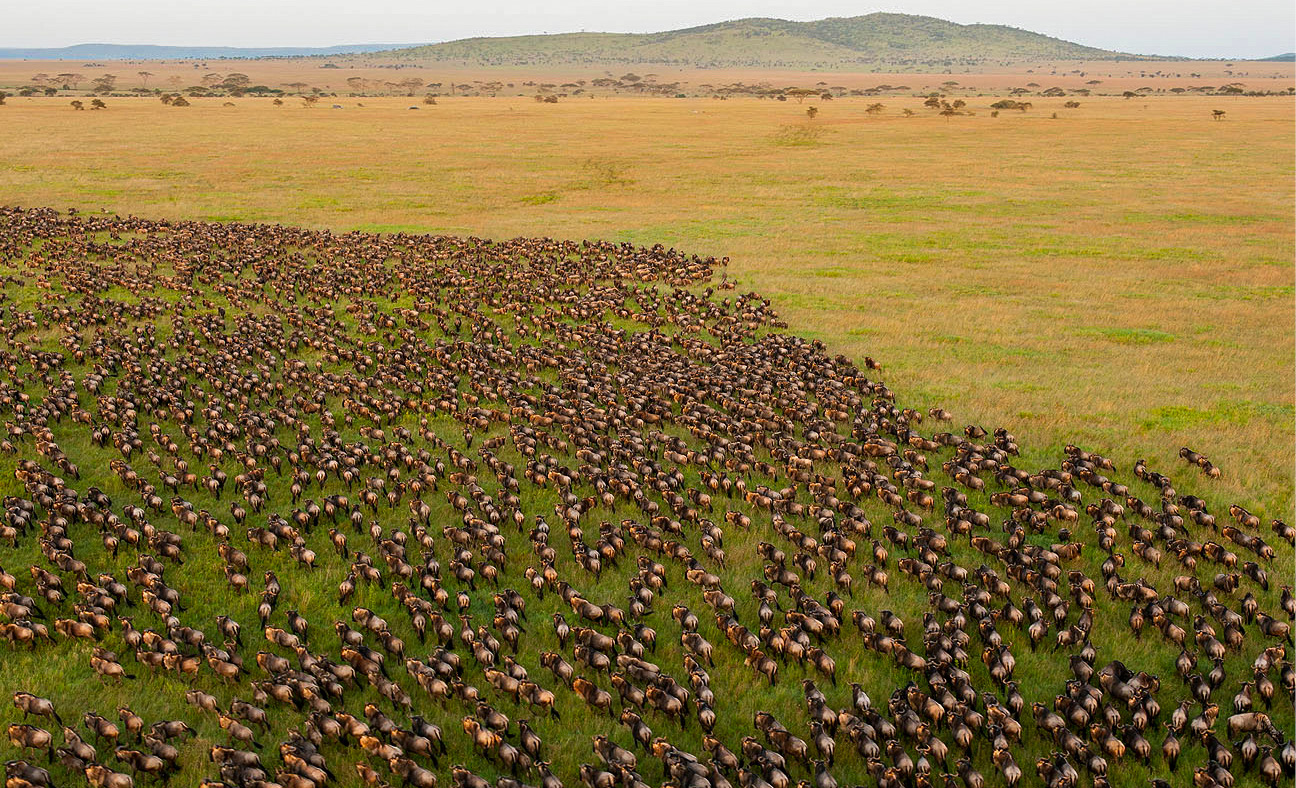
East Africa’s great migration is one of the most famous wildlife spectacles on Earth. Each year, tens of thousands of tourists from around the world flock to the region to see the 1.7 million common wildebeest (Connochaetes taurinus, LC) and hundreds of thousands of other plains mammals make their way from Tanzania’s Ngorongoro Conservation Area, through the Serengeti Plains, to Kenya’s Maasai Mara National Reserve. Photograph by Daniel Rosengren, https://commons.wikimedia.org/wiki/File:Wildebeest_Migration_in_Serengeti_National_Park,_Tanzania.jpg, CC BY 4.0.
Popular interest in protecting biological diversity—which describes the amazing range of species, genetic diversity within each species, and the multitude of Earth’s complex biological communities with their associated ecosystem processes—has intensified during the past few decades. During this time, scientists and the public have recognised that biological diversity (often shortened to biodiversity) is being lost at increasing rates. Across the world, human activities are destroying ecological communities that have developed over millions of years. Over the next several decades, thousands of species and millions of populations will likely go extinct.
The fundamental driver of all the biodiversity losses we are currently witnessing is a rapidly expanding human population coupled with increased consumptive needs. In 1850, after roughly 300,000 years of Homo sapiens on the planet, there were around 1 billion people on Earth. By 1987, not even 140 years later, the world’s human population had surpassed 5 billion. By 2017, there were 7.5 billion humans globally, of which over 1 billion lived in Sub-Saharan Africa (World Bank, 2019). With this many people, the human population grows by tens of millions of people each year, even with modest population growth (Figure 1.1). To make matters worse, Sub-Saharan Africa has the fastest population growth rate in the world, with a projected human population estimate of over 4 billion people by the year 2100—a number that is well beyond the ecological capacity of the region to support.
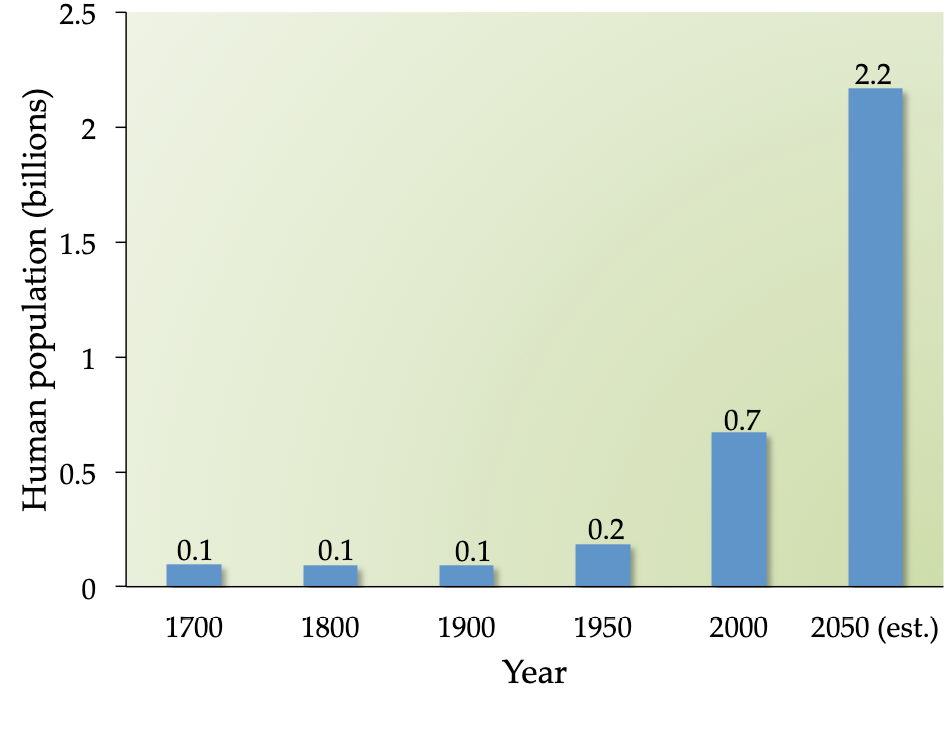
Figure 1.1 Sub-Saharan Africa’s human population crossed the 1 billion mark in 2015. At the current annual population growth rate of 2.7%, more than 28 million people will be added to the region in 2019. This number will escalate each subsequent year as increases are compounded. Sources: Biraben, 2003; World Bank, 2019, CC BY 4.0.
To survive and prosper, people use natural resources. They harvest and use oil, water, and wildlife products, and convert natural ecosystems for agriculture, cities, roads, and industrial activities. This consumption, which reduces natural habitat and the associated wildlife populations, is intensifying because of the demands of a rapidly increasing human population. Consumption of resources also increases as countries develop and industrialise: the average citizen of the USA uses five times more resources than the average global citizen, 11 times more than the average Chinese citizen, and 32 times more than the average Kenyan citizen (Worldwatch Institute, 2015). This growth in the number of humans, together with their ever-more-intensive use of natural resources, is the fundamental driver behind most current species extinctions.
For conservation biologists and other nature lovers, the widespread extinction of species and destruction of natural ecosystems are incredibly discouraging.
For conservation biologists and other nature lovers, the widespread extinctions of species and destruction of natural ecosystems are incredibly discouraging. Perhaps nowhere in the world is this issue as dramatic as in Africa with its rich and spectacular wildlife, but also its significant socio-economic challenges, such as a rapidly increasing human population, persistent poverty, weak governance structures, and many people’s near-obligate dependence on natural resources. Many Africans are also confused by the importance and need for conservation actions, pointing to the romanticised but inaccurate notion that humans have been living in relative harmony with nature since humans first made an appearance on Earth (see Box 8.1). But it is possible, and indeed necessary, to find ways to ensure the persistence of biodiversity. Actions taken, or not taken, during the next few decades will determine how many species and natural areas will continue to survive. Someday, people will likely look back and say that this time—the first half of the 21st century—was an important and exciting time when people worked together, and acted locally and globally, to prevent the extinction of many species and ecosystems. Examples of successful conservation efforts are described throughout this textbook.
1.1. Conservation Biology is Still Evolving
As a distinct scientific field, conservation biology is an integrated, multidisciplinary subject that developed in response to the challenge of preserving populations, species, ecosystems, and biological interactions. The main aim of conservation biology is to ensure the long-term preservation of biodiversity. To achieve its aim, conservation biology has set three goals:
- To document Earth’s biological diversity.
- To investigate how humans influence species, evolution, and ecosystem processes.
- To investigate practical approaches to protect and restore biological communities, maintain genetic diversity, and prevent the extinction of species.
The first two goals describe typical scientific research investigating objective facts. The third goal, however, is a part of what makes conservation biology a normative discipline; that is, conservation biology incorporates human values, not just facts, to understand and achieve its value-laden goals (Lindenmayer and Hunter, 2010). In this sense, conservation biology is related to environmentalism, in which people aim to protect the natural environment for its own sake (see Section 4.3.2). However, conservation biology is at its core a scientific discipline; it is founded on scientific principles. This is not to say you must be a scientist to practice conservation biology; there are many people who are not scientists who apply the principles of conservation biology in their professional and personal lives.
The emergence of conservation biology as a distinct scientific field in the 1970s has given rise to the formation of various formal societies representing the field in a united voice. Most notable among these is the Society for Conservation Biology (SCB, Figure 1.2), which is a non-profit international professional organisation with a mission to advance “the science and practice of conserving the Earth’s biological diversity”. To facilitate opportunities where like-minded people can share ideas locally, the SCB has regional branches, including an active Africa Section (http://conbio.org/groups/sections/africa) which hosts regular conferences. In addition to the SCB, a great number of other local, national, and regional conservation organisations also exist and act as mouthpieces for grassroots movements and as custodians of nature. Many of these groups focus on specific animals or local protected areas. Others organically adapt their missions and visions in response to a specific need or threat. For example, established in 1913 as an exchange forum between collectors of rare plants, the Botanical Society of South Africa now actively works toward protecting those rare plants in their natural habitats.
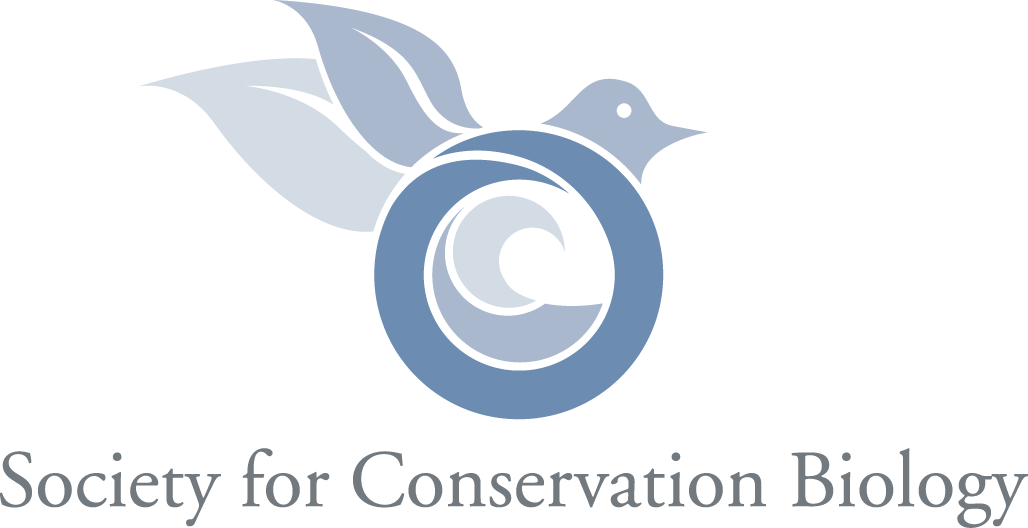
Figure 1.2 The logo of the Society for Conservation Biology (SCB) has several layers of symbolism. Enclosed in the circle of life are ocean waves, representing change. The bird symbolises beauty, and the leaves (the bird’s wings) remind us of nature’s productivity. Image courtesy of SCB, all rights reserved.
In recent years, conservation practice has evolved from just a plan to save the environment to a vision that includes sustainable development and social justice.
Conservation biology also has a history of adapting to new challenges. The very first conservation activities, in Africa and beyond, were geared towards securing the rights to valuable natural resources for people in powerful positions, such as kings and tribal chiefs, enforced through a strictly adherence to cultural norms and customary laws (Section 2.2). But as a growing human population expanded its influence on the environment, and wildlife started to decline, earliest conservation models gradually shifted towards fortress conservation approaches (Wilshusen et al., 2002) which aimed to shield wildlife from people by setting aside protected areas where human activities were strictly controlled.
Today, however, as human populations are exploding, and consumption is increasing, even protected areas are increasingly unable to withstand the multitude of threats to biodiversity that ignore property boundaries and political borders. In response, fortress conservation approaches are beginning to make way for large-scale integrated activities that highlight the social and economic benefits of biodiversity conservation. To do this, new alliances are being formed and new agendas are being established, such as those that directly link human health with environmental health (Box 1.1). These integrated conservation philosophies that pursue strategies that benefit both humans and biodiversity show much promise because they focus on fundamental extinction drivers, and advocate for more inclusive sustainable development. In this way, the practice of conservation has evolved from just a plan to save the environment to a vision that accomplishes its goals through sustainable development and social justice.
Yet, as we consider how to best invest limited conservation resources, some difficult questions arise. With seemingly more work to be done than can be accomplished, should we let some species go extinct (Bottrill et al., 2008)? Which species? Who decides? How can we even dare to think that we can play god? Such questions predictably bring about strongly opinionated and emotional debate (Soulé, 2013 vs. Marvier, 2014; Tallis and Lubchenco, 2014). Given the successful track record of fortress conservation initiatives in preventing extinctions despite limited budgets (Young et al., 2014), as well as the promising progress of more complex people-centred initiatives (Pooley et al., 2014), it seems clear that conservation relies on some balance between these two conservation philosophies (Sodhi et al., 2011). Conservation biologists of tomorrow will be able to fine-tune the balance between these strategies by closely inspecting the successes and failures of our actions today.
Box 1.1 Conservation Through Public Health: A Case Study
Conservation Through Public Health,
Kampala, Uganda.
http://www.ctph.org
Conservation Through Public Health (CTPH) is a grassroots non-governmental organisation (NGO) and non-profit that promotes biodiversity conservation by enabling people, wildlife, and livestock to coexist. The organisation was founded in 2003 after fatal scabies skin disease outbreaks in mountain gorillas (Gorilla beringei beringei, EN) were traced to people living around Bwindi Impenetrable National Park, Uganda, who had limited access to basic health services (Kalema-Zikusoka et al., 2002). Since then, CTPH has contributed to conservation and sustainable development in Africa by improving human and animal health and welfare in and around protected areas.
One of the main goals of CTPH is to reduce disease transfer between humans and gorillas. We accomplish this through an integrated population, health, and environment (PHE) programme that was established in 2007 with funding from the US Agency for International Development (USAID). As a first step, piloted around Bwindi, CTPH held consultative meetings with local leaders, during which at least one Village Health and Conservation Team (VHCT) volunteer was selected from each village and two from each parish (consisting of 11 villages) to oversee distribution of family planning supplies. This initiative rapidly expanded into a sustainable social service delivery network that promotes family planning, hygiene, and sanitation. The network resulted in a 20% to 60% (national average is 30%) increase in new users to modern family planning, and a 10% to 60% increase in adoption of hand washing facilities at homes visited by VHCTs. VHCT volunteers also refer people suffering from infectious diseases and malnutrition to local health centres and promote more sustainable alternative livelihoods. Another group of community volunteers, the “Human and Gorilla Conflict Resolution” (HUGO) team, in turn collect gorilla faecal samples left on communal land to monitor their health (Figure 1.A), and visually monitor gorillas for clinical signs of disease inside and outside protected areas (Gaffikin and Kalema-Zikusoka, 2010). In the process, we have seen reduced disease incidences in the gorillas, reduced conflict between people and gorillas, and improved attitudes toward conservation. One unintended outcome has been increased gender equality: men are now more involved in family planning, and women are more involved in natural resource management.
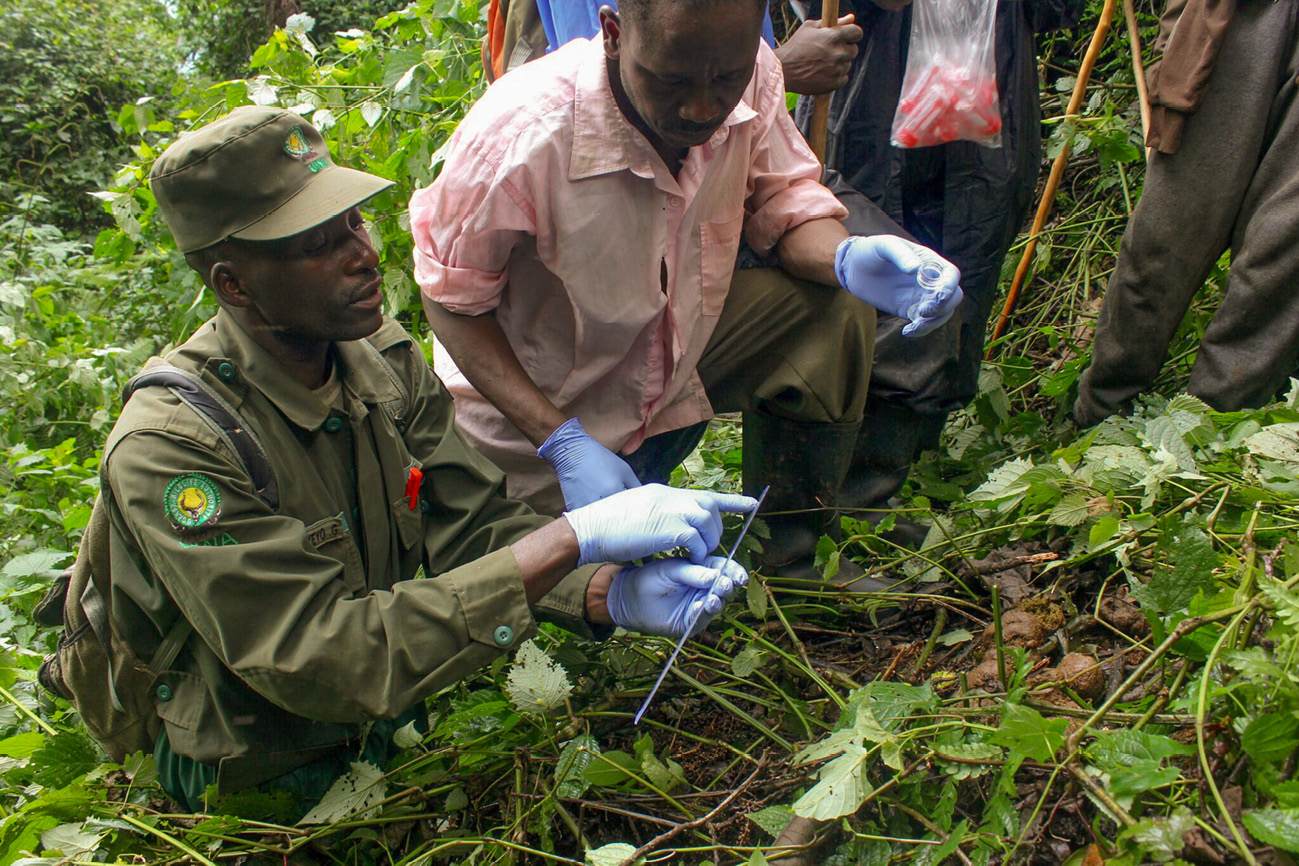
Figure 1.A A park ranger from the Uganda Wildlife Authority teaching HUGO community volunteers how to collect faecal samples from gorilla night nests during a CTPH training workshop. Photograph by CTPH, CC BY 4.0.
Our experience in initiating and managing PHE programmes for the past 10 years has taught us several lessons. One of the most important lessons to ensure project sustainability is to regularly engage with local leaders and the government. The Uganda Wildlife Authority, Uganda’s Ministry of Health, and local health centres all attend CTPH meetings with VHCTs. Attendance by and representation of these groups not only informs them of our activities, but also provides a platform to inform or train the VHCTs in what they would like them to disseminate to the local communities.
We have also learnt that PHE-implementing partners and projects need to be well-suited to each other and each site; this remains true even though health needs are often the same, regardless of the location. For example, at Mount Elgon National Park in Uganda, we found that training VHCTs in reducing conflict with park management played a key role in changing community attitudes toward conservation. In contrast, at Virunga National Park, Democratic Republic of the Congo (DRC), we found that VHCTs needed to work more closely with local health centres to prevent disease transmission between people and gorillas, and to promote family planning in a largely Catholic country.
Lastly, we found that establishing income-generating projects for groups rather than individuals was key to sustaining VHCT networks and programme goals beyond donor funding cycles where we have had no volunteer dropouts in the first 10 years of initiating the PHE programme. These key components were accomplished by initiating livestock group enterprises and by encouraging VHCT volunteers to invest generated income into Village Saving and Loan Associations (see http://www.care.org/vsla).
1.2 The Role of Conservation Biologists
While there are a few extinctions that have only one cause, more generally, extinctions occur because several factors acted simultaneously and/or sequentially. Blaming a certain industry or specific group of people for an extinction (or other biodiversity loss) is thus simplistic, ineffective, and often counter-productive. Though challenging, a better approach would be to better understand how local, national, and international links led to those losses, and to find viable alternatives to prevent it from happening again. To succeed in this challenge, conservation biologists should strongly consider taking on one or more of several roles:
- Conservation biologists should be curious. The world around us is full of natural wonders waiting to be discovered. These discoveries underpin conservation action, by allowing us to define all the different components of biodiversity, enabling us to better understand the needs of different species, and providing us with opportunities to celebrate our conservation successes.
- Conservation biologists must be good listeners. Sometimes, the only difference between attracting a new ally and making an enemy, or between developing a landscape and saving a species from extinction, is the way we communicate. Conservationists must be careful and respectful listeners, especially to opposing perspectives. Careful listening is particularly important in rural areas, where villagers often have practical concerns related to their daily contact with wildlife, such as staying safe and preventing crop damage and livestock loss. Quite often, those villagers may also have unique insights into wildlife ecology that could prove valuable in local conservation measures.
- Conservation biologists must be law-abiding citizens. Activities that involve wildlife and ecosystems are regulated by laws and regulations. These laws are important because ethical boundaries differ from person to person—activities acceptable to one group of people may be considered harmful by another. As conservation biologists, abiding by environmental laws is especially important if we want others to take those laws seriously.
Laws are important because ethical boundaries differ from person to person—activities acceptable to one person may be immensely harmful to another.
- Conservation biologists should become effective communicators. They should be able to discuss the problems facing biodiversity in depth, as well as the consequences of losing biodiversity, to as broad a range of people as possible. Groups like hunters, community leaders and organisers, and church leaders may be interested in participating in conservation efforts once they recognise that their activities, health, and emotional well-being depend on conservation action.
- Conservation biologists could become politically active leaders, so that they can influence public opinion and policy. As a starting point, those interested in this role can join a conservation organisation to learn more about broader issues. They could also use their personal networks to form alliances with lawyers, citizen groups, and politicians.
- Conservation biologists could become pro-active land managers. Those taking on this task must be willing to walk on the land and go out on the water to find out what is really happening. They should also talk with local people to communicate their knowledge to others in ways that are clear and easily understood.
- Above all, a conservation biologist must be honest. To encourage effective action, both from the public and through policy, conservationists must present arguments backed by reliable evidence. To do otherwise, conservation biologists could lose credibility, which would very likely delay or even compromise conservation efforts.
It is worth taking a moment to distinguish between two important pillars of conservation action, namely conservation advocacy and conservation science. Conservation advocacy describes the roles that conservation biologists adopt to guide social, political, and economical systems towards a personally-preferred outcome—adopting environmentally-friendly practices; incorporating these activities makes conservation biology a normative discipline. Conservation science, in contrast, describes activities that conservation biologists undertake to generate knowledge, like objectively describing biodiversity and measuring biodiversity’s response to stressors and safeguards. While conservation advocacy and conservation science often support and inform each other as to the next steps required for “doing conservation”, it is important to distinguish between these two pillars to ensure that policy makers and other stakeholders in the environment understand when we advocate for personal preferences and when we offer objective findings (Rykiel, 2001; Lackey, 2007; Nelson and Vucetich, 2009). The next section will further expand on the importance of science in conservation biology.
1.3 The Value of Scientific Methods
The field of conservation biology applies scientific methods to achieving its goals. Like the medical sciences, which apply principles from physiology, anatomy, and genetics to problems of human health, conservation biologists solve biodiversity problems using principles from fields, such as mathematics, veterinary medicine, social sciences, and several natural sciences (Figure 1.3). Conservation biology differs from these and other component disciplines in that its primary goal is the long-term preservation of biodiversity. Unlike many other scientific fields, conservation biology can also be described as a crisis discipline (Soulé, 1985; Kareiva and Marvier, 2012). That is, conservation biologists are often required to take creative steps to respond to imminent threats, typically without a complete knowledge of the systems requiring attention. Conservation scientists must also articulate long-term visions for conservation beyond solving immediate problems.
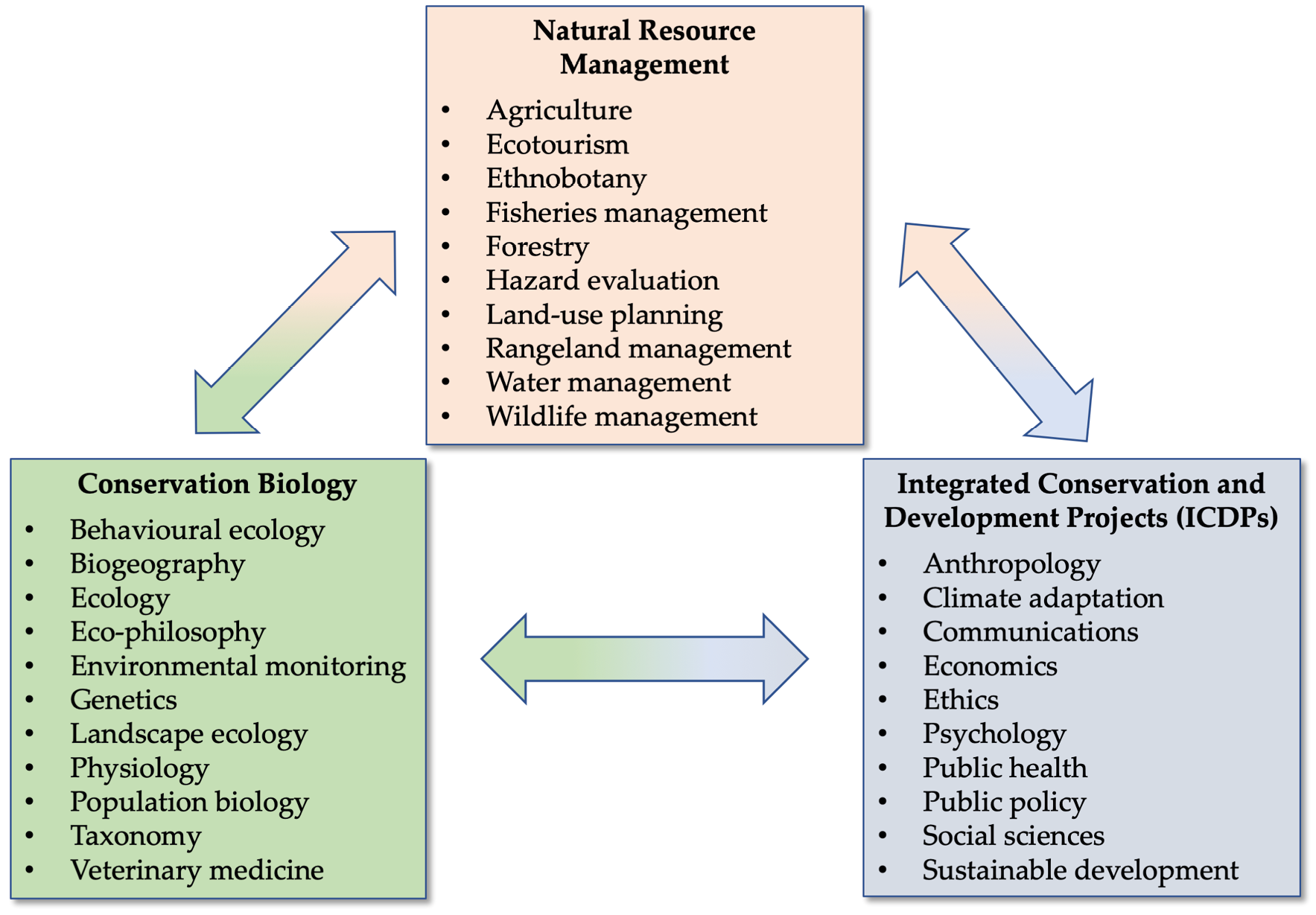
Figure 1.3 Conservation biology draws from many other sciences to protect biodiversity. It is closely related to natural resource management, which aims to manage biodiversity primarily for the benefit of humans. Integrated conservation and development projects (ICDP) are projects that manage nature for the benefit of both humans and biodiversity. After Kareiva and Marvier, 2012; Temple, 1991, CC BY 4.0.
To be effective, conservation biologists must demonstrate the relevance of their findings to a range of stakeholders. To be successful in this task, the importance of sound scientific principles cannot be over-emphasised. Nature is a complex network of many interdependent connections and feedback loops. Science is underpinned by principles that provide conservationists the necessary quantitative and qualitative tools to better measure and control for all these different aspects of biodiversity. Such measurements allow us to gain a better understanding of complex natural systems, and the consequences of human activities. Reliable, unbiased data obtained from sound and transparent scientific methods also facilitate policy making that is too often based on value judgments by non-experts who must balance many needs and different sources of information (Ntshotsho et al., 2015).
One of the cornerstones of modern science is to identify a hypothesis (a proposed explanation for a specific observation) to evaluate. The best hypotheses, often expressed as goals or objectives, are usually those that are SMART:
Setting specific, measurable, realistic and timebound goals and objectives is essential for effective conservation.
|
Specific: not overly general; |
|
Measurable: has both units and a method of measurement; |
|
Attainable: realistic to achieve; |
|
Relevant: related to what needs to be accomplished; |
|
Time-bound: achievable within a specific timeframe. |
Identifying SMART goals and objectives is an essential aspect of conservation biology. Without such benchmarks, practitioners cannot know whether their tasks were successful, or when management actions should be adjusted to achieve success. While this may seem obvious, many previous conservation projects have failed because biologists neglected to set SMART goals and objectives (Tear et al., 2005). While lofty, “We’re going to save all species” is not a SMART conservation goal because it is overly general, hard to measure, unrealistic, and not time bound. In contrast, “We want to protect 25% of our country’s wetlands within the next 10 years” is a SMART goal because it sets a very clear and measurable objective. In general, it is wise to set smaller short-term (e.g. quarterly), and medium-term (e.g. annual) goals as one works towards long-term (e.g. 5–10 years) objectives; this allows one to constantly assess progress, which in turn provides opportunities for celebrations and strategic adjustments as and when needed.
Too many conservation decisions are based on biased anecdotes, personal intuition, and myths.
Another scientific standard that conservation practitioners must adopt at a larger scale is the transfer of knowledge gained from unique and specialist experiences. Conservation activities are too often hampered by the lack of guidance from credible and available sources. This forces conservationist managers to base important decisions on biased anecdotes, personal intuition, and even myths (Sutherland et al., 2004). Successful conservation actions on the other hand often rely on results and guidelines that were disseminated to the broader community by practitioners who faced similar challenges earlier. To maximise this learning from each other’s successes and mistakes, it is crucial for conservation scientists and managers to make every effort to ensure knowledge transfer, by carefully tracking their activities, and publishing their results and experiences in scientific journals and reports.
Biodiversity conservation, however, is not accomplished by simply setting SMART goals, measuring outcomes, and publishing results in scientific journals and reports. It is also important for conservation biologists to engage in public outreach activities, during which they can build on the public’s existing connection to nature, help them better understand the value of biodiversity in their local area, and enable them to actively contribute in conservation projects. When interacting with the public, conservation practitioners must be sensitive to the complicated emotions and diverging interests of different groups of people (Milfont et al., 2017), especially vulnerable peoples who may be negatively impacted—hopefully only in the short term—by conservation actions. This requires a sense of emotional awareness, because the words we choose matter when we encourage others to care for and reduce their impact on nature. Equally important, conservation biologists, as with any field of science, should be sceptical of their results. The process of generating data is not equal to generating facts, because data can be fraught with bias, imprecision, and uncertainty. This is perhaps even more important when sharing findings with lay people, as scientists have rigorous training in understanding uncertainty and connecting cause and effect. Putting scientific findings in context with adequate and clear explanation is a challenge to all scientists, but it is necessary, especially when partnering with conservationists not specifically trained as scientists.
1.4 Environmental Ethics
Most human societies today aim to protect biodiversity through rules and regulations (Chapter 12). An alternative approach is to change the fundamental materialistic values of modern society to values that prioritise genuine and lasting human well-being. This is the goal of environmental ethics, a discipline within philosophy that emphasises the ethical values of biodiversity. The foundation of environmental ethics lies in the philosophical principle that every organism of Earth has a right to exist, regardless of its usefulness to humans, so any action that negatively impacts biodiversity would be considered unethical.
Because human quality of life is intricately linked to the ability of the natural world to prosper (Chapter 4), the ethical arguments for biodiversity conservation hold even for people who value only human life. Or, in other words, respect for human life—even our instincts for self-preservation—should compel us to preserve biodiversity. In contrast, if we neglect our assumed responsibility to act as guardians of life on Earth, future generations will suffer with a lower quality of life. We can already see signs of this today: as species are lost and natural ecosystems replaced with sprawling cities, children are increasingly deprived of the wonderful experience of seeing a ‘new’ animal (Figure 1.4) or pretty flower. We can imagine that we are borrowing Earth from future generations, and that it is our responsibility to ensure that they receive it in good condition.
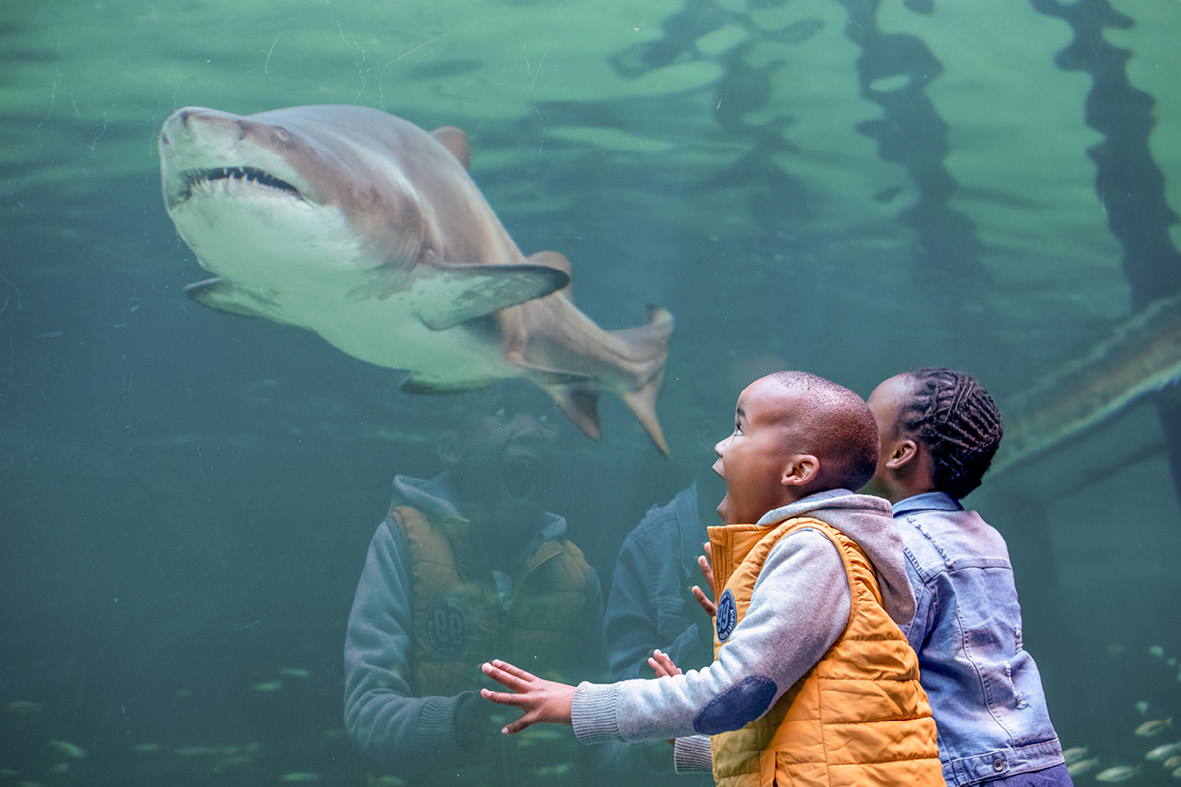
Figure 1.4 A ragged-tooth shark (Carcharias taurus, VU) fascinates two kids at the Two Oceans Aquarium, South Africa. People—and especially kids— enjoy seeing wildlife, as shown by the increased popularity of protected areas, zoos, and other institutions where biodiversity can be seen. Photograph by Karen Schermbrucker, courtesy of Two Oceans Aquarium, CC BY 4.0.
Because of this close link between nature and human well-being, the concept of nature preservation has permeated through the value systems of most human cultures, philosophies, and religions throughout history. This is especially relevant in Africa, where most (if not all) traditional societies have a deep connection with nature that is woven into their spiritual beliefs and customs (Figure 1.5). Our responsibility to protect animals is also explicitly described in Jewish, Christian, and Islamic traditions. Other major religions, including Hinduism, Buddhism, and Taoism also strongly support the preservation of non-human life. In light of accelerated biodiversity losses, faith-based groups have recently started playing a more active role in conservation, particularly among urbanised people. They do this by informing adherents that it is wrong to allow the destruction of nature, and that such destructive activities can have negative consequences for all people on Earth. These links between faith-based organisations and conservation have given rise to consortiums such as the Forum on Religion and Ecology (http://fore.yale.edu), the Alliance of Religions and Conservation (http://www.arcworld.org), and the SCB’s Religion and Conservation Working Group (https://twitter.com/ReligionConBio), as well as the emerging field of spiritual ecology (Vaughan-Lee, 2016).
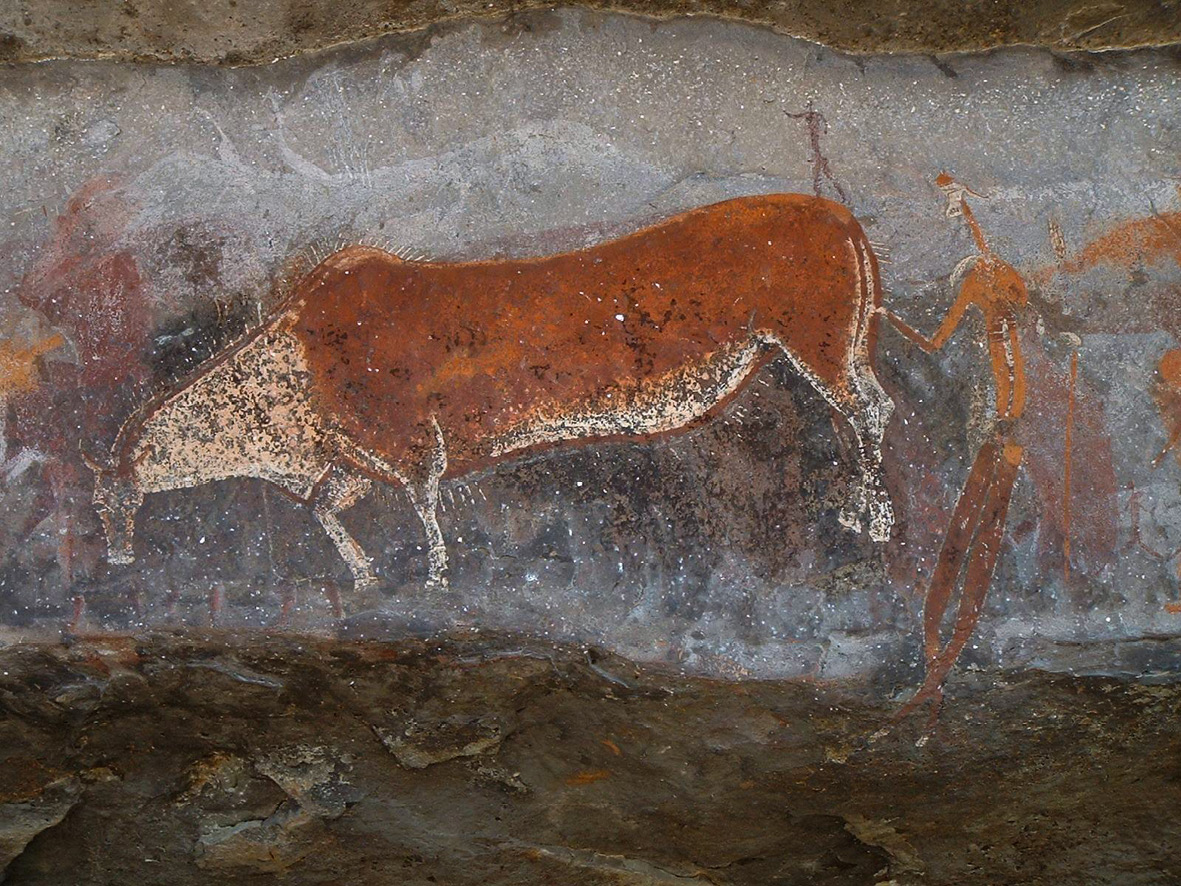
Figure 1.5 The spiritual connection between people and nature features strongly in ancient rock art made by Bushmen (also known as San, or First People) of Southern Africa, believed to be the oldest human population on Earth. Pictured here is a common eland (Tragelaphus oryx, LC), drawn by shamans to open the portals of the spiritual world. Photograph by Alan Manson, https://commons.wikimedia.org/wiki/File:Shaman_at_work_Game_Pass_2004_0522_121946AA.jpg, CC BY 4.0.
Environmental ethics has strong links to the environmental justice movement and has recently established strong ties to the social justice movement. Some of the most exciting developments in this direction involve initiatives that combine protection activities with community upliftment programmes that improve the well-being of local peoples (Box 1.2; see also Section 14.3). These developments have shown that when poor and marginalised people are empowered to protect the environment, they may act as strong local guardians of forests, coastal areas, and other ecosystems that may have been destroyed otherwise.
Box 1.2 The Okapi Wildlife Reserve: Protecting Nature and Providing for People
Okapi Conservation Project,
Okapi Wildlife Reserve,
Epulu, DRC.
https://www.okapiconservation.org
The Okapi Wildlife Reserve, a World Heritage Site in peril, is located within the dense, tropical Ituri Forest in north-eastern DRC. The reserve was created to protect the okapi (Okapia johnstoni, EN) (Stephenson and Newby, 1997). Researchers estimate that there are between 10,000 and 25,000 okapi (Figure 1.B) left in the wild, but with populations appearing to have declined by more than 50% over the last 15 years (Kümpel et al., 2015). The reserve also protects charismatic species like forest elephants (Loxodonta cyclotis), 14 species of primates, including chimpanzees (Pan troglodytes, EN), leopards, forest buffalo (Syncerus caffer nanus), and bongo antelope (Tragelaphus eurycerus, NT).
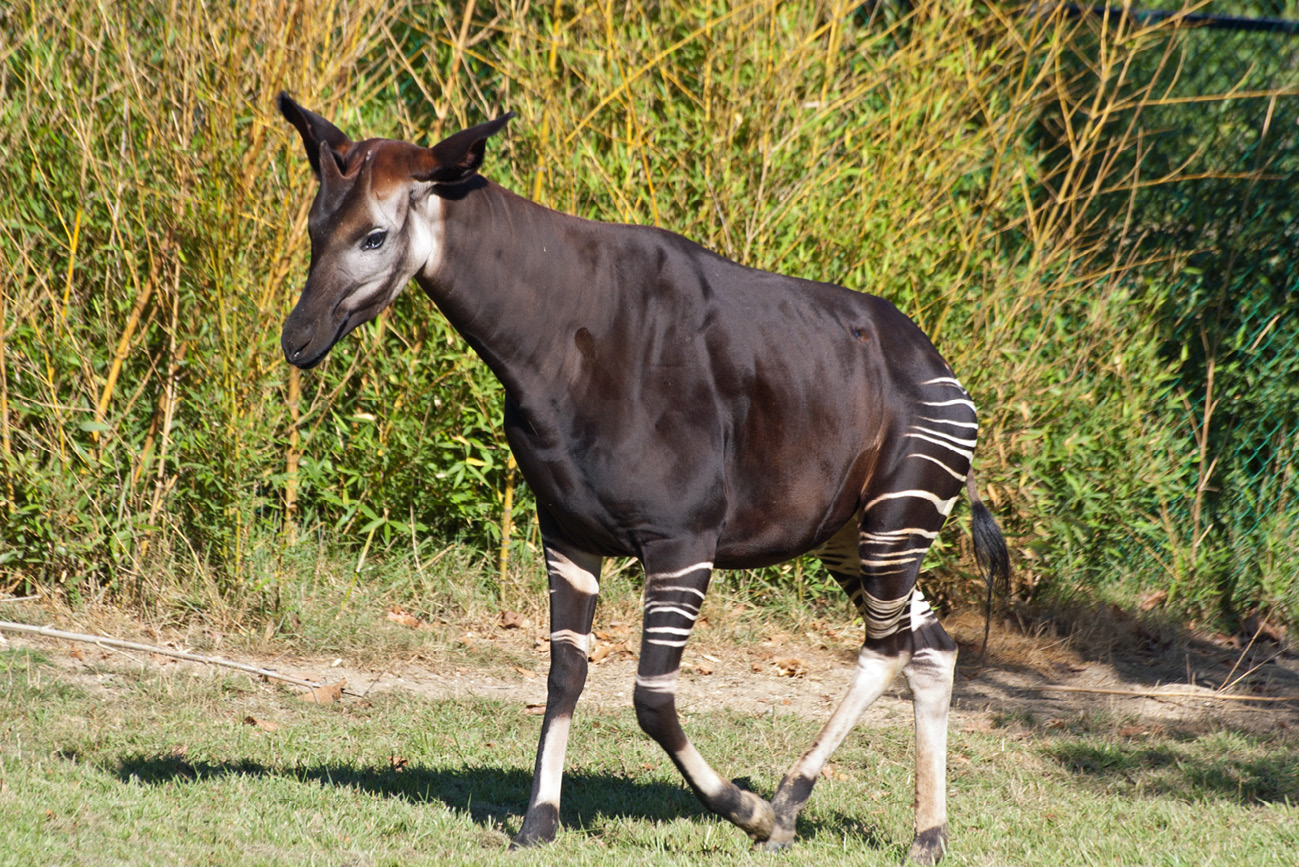
Figure 1.B The okapi, a relative of the giraffe, at ZooPark de Beauval, France. This species, one of the DRC’s natural treasures, survives only because of the dedication of a devoted group of conservation biologists. Photograph by Daniel Jolivet, https://www.flickr.com/photos/sybarite48/7973333500, CC BY 2.0.
Since 1987, the Okapi Conservation Project has partnered with the Congo Institute for Conservation of Nature, the government agency responsible for the Okapi Wildlife Reserve’s management, to provide financial and technical support for the operation of the reserve and preservation of the surrounding Ituri Forest. The project is partially managed and funded by Wildlife Conservation Global, a non-profit NGO based in Florida, USA.
Despite the support, conservation managers in this region face various challenges due to political instability since the 1990s. This has led to the deaths and displacement of millions of residents and rampant poaching in the area and beyond. Epulu Station, the reserve’s headquarters, was tragically attacked in 2012, resulting in hostage taking, destruction and looting of the headquarters’ infrastructure, and the deaths of staff and families, as well as 14 okapis at the captive breeding station.
To meet its goals in this difficult environment, the Okapi Conservation Project has seven objectives aimed at enhancing conservation, safety, and community:
- Financially supporting the operation of the reserve, paying warden and guard bonuses, building informer and monitoring networks, and providing necessities, such as food rations for patrols, fuel and spare parts for travel and field equipment.
- Maintaining and building infrastructure in the region that includes an airstrip, okapi pens, patrol posts for rangers, and high-quality tourism facilities. The project has also outfitted 20 health centres with necessities and has overseen the refurbishment and setup of territory offices in Mambasa and Wamba, the construction of a primary school in Epulu, and rehabilitation of medical dispensaries in Sondo and Koki.
- Breeding okapi in captivity for release into their natural habitat to boost non-captive population numbers and genetic diversity. Between 1987 and 2012, the project succeeded in producing 11 calves.
- Promoting environmental education, public engagement, and public awareness. Project staff achieves this by developing and implementing school programmes in and around the reserve, presenting seminars in primary and secondary schools, and producing radio broadcasts. They also facilitate focus group meetings with women and farmers, public meetings in villages, work with local committees, and produce outreach materials such as conservation films, calendars, leaflets, and posters. The Okapi Conservation Project has already supplied 112 schools with educational materials.
- Facilitating tourism activities, including visits around the Epulu Station and zoo, forest walks, and participation in traditional hunting.
- Promoting food security in local communities by providing seeds and farming tools to more than 900 farmers in and around the reserve. In addition, more than 142 women have benefited from sewing and embroidery materials, and participation in community farm fields.
- Offering medical care to more than 300 families, a total of more than 1,500 family members, who work at the reserve.
The work of staff at the Okapi Conservation Project and Congo Institute for Conservation of Nature is not easy due to political instability, breakdown of law and order, and lack of financial security. The Reserve and surrounding area also face increasing pressures from mining, poaching, and logging interests. But the project is necessary to help preserve the unique biodiversity of this Global Biodiversity Hotspot. In coming years, we hope that governance of the region will continue to improve and restore peace, justice, and the socio-economic status of local people. In such a situation, local communities and ecosystems, including the okapi, will benefit.
1.4.1 Conservation biology’s ethical principles
Conservation biology rests on a set of underlying ethical principles that is generally agreed upon (Soulé, 1985) and can be summarised as follows:
- The diversity of species and biological communities should be preserved: Most people appreciate biodiversity. Hundreds of millions of people visit national parks, game reserves, zoos, botanical gardens, and aquaria each year. They spend money and take actions to protect these places and species. People also recognise that biodiversity has economic value, whether through tourism, consumption, or other services.
- The untimely extinction of populations and species should be prevented: Throughout history, species have occasionally died off as a result of natural, non-human causes. The loss of a local population was generally temporary, until a new population established itself through dispersal. However, human activities have increased the rate at which species are going extinct by more than a hundredfold (Box 1.3). Meanwhile, there is no similar increase in the rate at which new populations and species are being created.
- Ecological complexity should be maintained: In complex natural environments, biodiversity expresses many of its most valuable features and interactions. Although the biodiversity of species may be partially preserved in captivity, maintaining ecological complexity requires that natural areas be preserved.
- Evolution should continue: Evolution creates new species, increases biodiversity over time, and facilitates adaptation to changing environmental conditions. People can help preserve these evolutionary processes by maintaining genetic diversity in wild populations and allowing populations to exchange genetic material. In captivity, many natural evolutionary processes do not occur, which can hamper survival when species are reintroduced in the wild.
- Biodiversity has intrinsic value: The value of species, communities, and ecosystems does not depend on their utility to people. They are intrinsically valuable on their own, with unique evolutionary histories and ecological roles. There are certain iconic species that people simply want to have around, but other, lesser-known species or species seen as problematic to people are not less valuable.
Box 1.3 Biodiversity: Can Humanity be Saved?
Regina International Cameroon,
Member of Union Farms of Africa,
Yaoundé, Cameroon.
vnkeh@yahoo.com
What happened over the past 200 years that we have arrived where we are? How did we get to this modern paradox? A society where we cherish comfort at the cost of the ever-increasing destruction of our planet. Never in the history of humanity has the environment been degraded to the point that even the air we breathe has become cancerous. Animals are exploited by industries at an alarming rate and those remaining are killed to enrich a privileged few. And all this evil happens with our complicity as indirect consumers. Our inheritance from God, the source of all our nourishment, does not belong to us. Yet it has been bought and exploited by multinational corporations and financial markets that hinder us from cultivating sustainably. We are pushed to feed ourselves and our crops with chemical products that are dangerous to our long-term health. We are also experiencing the start of the sixth mass extinction episode of biodiversity (Ceballos et al., 2017). As a result, the natural world has declared World War III against humanity. This is a war fought not by nation against nation, but that the environment has declared against the whole human race.
This war condemns us to live in an illusion of freedom; we are, in fact, destroyed at an increasing rate by different dangerous diseases and rendered slaves of the polluted environments that we blindly accept. The question we need to ask is not whether we should act to save our planet, but what future and meaning we are going to give the word “HUMANITY”. We are all actors in a civilisation that we are constructing; to quote the Indian leader Mahatma Gandhi: “If we could change ourselves, the tendencies in the world would also change. As a man changes his own nature, so does the attitude of the world change towards him. […] We need not wait to see what others do”. Let us pause and ask ourselves what we want the future to say of us. Are we a destructive generation, or a generation that is ready to sustainably preserve its biodiversity? It is a question every reader needs to ponder. The future is judging no one and blaming no one, but it needs us to change our habits towards protecting the world’s biodiversity.
To change our attitude and make the world a better place, I drafted the following poem with passion to see my words become action for every lover of biodiversity
WORLD CHANGERS
WE ARE A PEOPLE OF PEACE CALLED FORTH OUT OF HUMANITY INTO RESTORING LIFE TO OUR NATURAL HABITAT.WE ARE GOVERNED AND GUIDED BY A SENSE OF SUSTAINABILITY.CONSERVATION AND PROTECTION IS OUR PRIORITY IN ALL THINGS AT ALL TIMES WE ARE LED AND DRIVEN BY THE SPIRIT OF AN ENVIRONMENT FREE OF POLLUTION WE ARE CALLED TO EFFECT AND AFFECT EVERY LIFE THAT WE COME IN CONTACT WITH TOWARDS THE SUSTAINABLE DEVELOPMENT OF THE ENVIRONMENT
WE ARE CALLED BY HUMANITY TO BE WORLD CHANGERS WE REFUSE TO CONFORM WITH THE THINKING PATTERN OF THE WORLD SYSTEM BECAUSE WE ARE WORLD CHANGERS
These principles are not absolute, nor are conservation biologists required to agree with them—they are actively discussed and debated. But many individuals and organisations agree with two, three, or all the principles, and support conservation efforts.
1.5 Summary
- Conservation biology has three goals: (a) to document Earth’s biological diversity; (b) to investigate how humans influence species, evolution, and ecosystem processes; and (c) to investigate approaches to protect and restore biological communities, maintain genetic diversity, and prevent the extinction of species.
- Because conservation is multidisciplinary and requires a deep understanding of natural processes and human society, conservation biologists must take on multiple roles. Specifically, conservation biologists, as a group, must be curious, good communicators, effective educators, law-abiding citizens, and effective managers and practitioners of conservation projects.
- Conservation biology relies on scientific evidence and ethical principles that underpins the preservation of biodiversity. Conservation biologists generally agree that biodiversity should be preserved, untimely extinctions should be prevented, ecological complexity should be maintained, evolution should continue, and biodiversity has intrinsic value.
- Science provides conservation biologists with useful tools that guide the setting of clear, achievable, and measurable goals, to monitor conservation actions to assess whether goals have been met, and to communicate in a clear and unbiased manner.
- Environmental ethics appeals to people of different walks to life to preserve biodiversity. It holds that biodiversity must also be protected because human well-being and economic opportunities are linked to a healthy environment.
1.6 Topics for Discussion
- Is conservation biology substantially different in its approach from other fields of science, such as physics, chemistry, or medicine? If so, how? How is it linked to but different from environmentalism and social justice?
- Looking at the titles of Chapters 5–7, what do you think are the biggest threats to biodiversity near where you live? Explain your answers.
- There have been three broad conservation approaches throughout history: early models that secured natural resources for powerful people, fortress conservation, and integrated conservation. How do these approaches differ and how do they complement each other? How do you think each of these approaches can contribute to conservation today?
- Which statements about the ethical principles of conserving biodiversity in this chapter do you agree with? Which do you disagree with? Explain your answers.
1.7 Suggested Readings
Bottrill, M.C., L.N. Joseph, J. Carwardine, et al. 2008. Is conservation triage just smart decision making? Trends in Ecology and Evolution 23: 649–54. https://doi.org/10.1016/j.tree.2008.07.007 Should we let some species go extinct?
Elosegi, A., M.O. Gessner, and R.G. Young. 2017. River doctors: Learning from medicine to improve ecosystem management. Science of the Total Environment 595: 294–302. https://doi.org/10.1016/j.scitotenv.2017.03.188 Comparing conservation to the health sciences
Illingworth, S. 2017. Delivering effective science communication: Advice from a professional science communicator. Seminars in Cell and Developmental Biology 70: 10–16. https://doi.org/10.1016/j.semcdb.2017.04.002 Tips to help you better communicate with public audiences.
Kareiva, P., and M. Marvier. 2012. What is conservation science? BioScience 62: 962–69. https://doi.org/10.1525/bio.2012.62.11.5 A review of an article published in 1985, offering a revised set of core principles that should guide conservation biology today.
Meyer, J.L., P.C. Frumhoff, S.P. Hamburg, et al. 2010. Above the din but in the fray: environmental scientists as effective advocates. Frontiers in Ecology and the Environment 8: 299–305. https://doi.org/10.1890/090143 Scientists have a responsibility to be advocates as well as researchers.
Sutherland, W.J., A.S. Pullin, P.M. Dolman, et al. 2004. The need for evidence-based conservation. Trends in Ecology and Evolution 19: 305–08. https://doi.org/10.1016/j.tree.2004.03.018 How do conservationists make decisions?
Tallis, H., and J. Lubchenco. 2014. Working together: A call for inclusive conservation. Nature 515: 27–28. https://doi.org/10.1038/515027a There is a risk that conservation can be polarising. We should rather be working together.
Tear, T.H., P. Kareiva, P.L. Angermeier, et al. 2005. How much is enough? The recurrent problem of setting measurable objectives in conservation. BioScience 55: 835–49. https://doi.org/10.1641/0006-3568(2005)055[0835:HMIETR]2.0.CO;2 Guidelines for setting goals in conservation.
Bibliography
Biraben J.-N. 2003. The rising numbers of humankind. Populations and Societies 394: 1–4. https://www.ined.fr/en/publications/population-and-societies/the-rising-numbers-of-humankind-en
Bottrill, M.C., L.N. Joseph, J. Carwardine, et al. 2008. Is conservation triage just smart decision making? Trends in Ecology and Evolution 23: 649–54. https://doi.org/10.1016/j.tree.2008.07.007
Ceballos, G., P.R. Ehrlich, and R. Dirzo. 2017. Biological annihilation via the ongoing sixth mass extinction signalled by vertebrate population losses and declines. Proceedings of the National Academy of Sciences 114: E6089–E6096. https://doi.org/10.1073/pnas.1704949114
Gaffikin, L., and G. Kalema-Zikusoka. 2010. Integrating human and animal health for conservation and development: Findings from a program evaluation in southwest Uganda (Kampala: CTPH; Stanford: EARTH, Inc.; Boston: John Snow, Inc). https://www.jsi.com/JSIInternet/Inc/Common/_download_pub.cfm?id=11196&lid=3
Kalema-Zikusoka, G., R.A. Kock, and E.J. Macfie. 2002. Scabies in free-ranging mountain gorillas (Gorilla beringei beringei) in Bwindi Impenetrable National Park, Uganda. Veterinary Record 150: 12–15. http://doi.org/10.1136/vr.150.1.12
Kareiva, P., and M. Marvier. 2012. What is conservation science? BioScience 62: 962–69. https://doi.org/10.1525/bio.2012.62.11.5
Lackey, R.T. 2007. Science, scientists, and policy advocacy. Conservation Biology 21: 12–17. https://doi.org/10.1111/j.1523-1739.2006.00639.x
Lindenmayer, D., and M. Hunter. 2010. Some guiding concepts for conservation biology. Conservation Biology 24: 1459–68. https://doi.org/10.1111/j.1523-1739.2010.01544.x
Marvier, M. 2014. New conservation is true conservation. Conservation Biology 28: 1–3. https://doi.org/10.1111/cobi.12206
Milfont, T.L., P.G. Bain, Y. Kashima, et al. 2017. On the relation between social dominance orientation and environmentalism: A 25-nation study. Social Psychological and Personality Science 2017: 1948550617722832. https://doi.org/10.1177/1948550617722832
Nelson, M.P., and J.A. Vucetich. 2009. On advocacy by environmental scientists: what, whether, why, and how. Conservation Biology 23: 1090–101. https://doi.org/10.1111/j.1523-1739.2009.01250.x
Ntshotsho, P., H.E. Prozesky, K.J. Esler, et al. 2015. What drives the use of scientific evidence in decision making? The case of the South African Working for Water program. Biological Conservation 184: 136–44. https://doi.org/10.1016/j.biocon.2015.01.021
Pooley, S., J.A. Mendelsohn, and E.J. Milner-Gulland. 2014. Hunting down the chimera of multiple disciplinarity in conservation science. Conservation Biology 28: 22–32. http://doi.org/10.1111/cobi.12183
Sodhi, S.N., R. Butler, W.F. Laurance, et al. 2011. Conservation successes at micro-, meso- and macroscales. Trends in Ecology and Evolution 26: 585–94. https://doi.org/10.1016/j.tree.2011.07.002
Soulé, M.E. 1985. What is conservation biology?: A new synthetic discipline addresses the dynamics and problems of perturbed species, communities, and ecosystems. BioScience 35: 727–34. https://doi.org/10.2307/1310054
Soulé, M.E. 2013. The “new conservation.” Conservation Biology 27: 895–97. https://doi.org/10.1111/cobi.12147
Stephenson, P.J., and J.E. Newby. 1997. Conservation of the Okapi Wildlife Reserve, Zaïre. Oryx 31: 49–58. https://doi.org/10.1046/j.1365-3008.1997.d01-3.x
Sutherland, W.J., A.S. Pullin, P.M. Dolman, et al. 2004. The need for evidence-based conservation. Trends in Ecology and Evolution 19: 305–08. https://doi.org/10.1016/j.tree.2004.03.018
Tallis, H., and J. Lubchenco. 2014. Working together: A call for inclusive conservation. Nature 515: 27–28. https://doi.org/10.1038/515027a
Tear, T.H., P. Kareiva, P.L. Angermeier, et al. 2005. How much is enough? The recurrent problem of setting measurable objectives in conservation. BioScience 55: 835–49. https://doi.org/10.1641/0006-3568(2005)055[0835:HMIETR]2.0.CO;2
Temple, S.A. 1991. Conservation biology: New goals and new partners for managers of biological resources. In: Challenges in the Conservation of Biological Resources: A Practitioner’s Guide, ed. by D.J. Decker, et al. (Boulder: Westview Press).
Vaughan-Lee, L. 2016. Spiritual Ecology: The Cry of the Earth (Point Reyes: Golden Sufi Center).
Wilshusen, P.R., S.R. Brechin, C.L. Fortwangler, et al. 2002. Reinventing a square wheel: Critique of a resurgent “protection paradigm” in international biodiversity conservation. Society and Natural Resources 15: 17–40. https://doi.org/10.1080/089419202317174002
World Bank. 2019. World Bank Open Data: Sub-Saharan Africa. http://data.worldbank.org/region/sub-saharan-africa
Worldwatch Institute. 2015. Vital Signs, v. 22: The Trends that are Shaping our Future (Washington: The Worldwatch Institute). http://www.worldwatch.org/Vital-Signs-22
Young, R.P., M.A. Hudson, A.M.R. Terry, et al. 2014. Accounting for conservation: Using the IUCN Red List Index to evaluate the impact of a conservation organization. Biological Conservation 180: 84–96. https://doi.org/10.1016/j.biocon.2014.09.039

